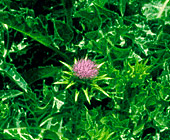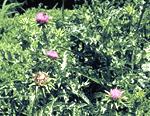
® 2004 Horticopia, Inc.
Photography by Robert E. Lyons
On this page:
- Introduction
- What It Is Used For
- How It Is Used
- What the Science Says
- Side Effects and Cautions
- Sources
- For More Information
Introduction
This fact sheet provides basic information about the herb, milk thistle—common names, uses, potential side effects, and resources for more information. Milk thistle is a flowering herb that is native to the Mediterranean region. It has been used for thousands of years as a remedy for a variety of ailments, especially liver problems.
Common Names—milk thistle, Mary thistle, holy thistle. Milk thistle is sometimes called silymarin, which is actually a mixture of the herb's active components, including silybinin (also called silibinin or silybin).
Latin Name—Silybum marianum
What It Is Used For
Milk thistle is believed to have protective effects on the liver and improve its function. It is typically used to treat liver cirrhosis, chronic hepatitis (liver inflammation), and gallbladder disorders. Treatment claims also include:
- Lowering cholesterol levels
- Reducing insulin resistance in people with type 2 diabetes who also have cirrhosis
- Reducing the growth of cancer cells in breast, cervical, and prostate cancers
How It Is Used
Silymarin, which can be extracted from the seeds (fruit) of the milk thistle plant, is believed to be the biologically active part of the herb. The seeds are used to prepare capsules, extracts, and infusions (strong teas).
What the Science Says

- There have been some studies of milk thistle on liver disease in humans, but these have been small. Some promising data have been reported, but study results at this time are mixed.
- Although some studies conducted outside the United States support claims of oral milk thistle to improve liver function, there have been flaws in study design and reporting. To date, there is no conclusive evidence to prove its claimed uses.
- Recent NCCAM-funded research includes a phase II study to better understand the use of milk thistle for chronic hepatitis C. Additional research, cofunded by NCCAM and the National Institute of Diabetes and Digestive and Kidney Diseases, includes studies of milk thistle for chronic hepatitis C and nonalcoholic steatohepatitis (liver disease that occurs in people who drink little or no alcohol).
- The National Cancer Institute and the National Institute of Nursing Research are also studying milk thistle, for cancer prevention and to treat complications in HIV patients.
Side Effects and Cautions
- In clinical trials, milk thistle generally has few side effects. Occasionally, people report a laxative effect, upset stomach, diarrhea, and bloating.
- Milk thistle can produce allergic reactions, which tend to be more common among people who are allergic to plants in the same family (for example, ragweed, chrysanthemum, marigold, and daisy).
- Tell your health care providers about any complementary and alternative practices you use. Give them a full picture of what you do to manage your health. This will help ensure coordinated and safe care.
Sources
- Agency for Healthcare Research and Quality. Milk Thistle: Effects on Liver Disease and Cirrhosis and Clinical Adverse Effects. Evidence Report/Technology Assessment no. 21. Rockville, MD: Agency for Healthcare Research and Quality; 2000. 01-E024.
- Milk thistle (Silybum marianum). In: Coates P, Blackman M, Cragg G, et al., eds. Encyclopedia of Dietary Supplements. New York, NY: Marcel Dekker; 2005:467–482.
- Milk thistle. Natural Medicines Comprehensive Database. Accessed on July 3, 2007.
- Milk thistle (Silybum marianum), silymarin. Natural Standard Database Web site. Accessed on June 28, 2007.
- Milk thistle fruit. In: Blumenthal M, Goldberg A, Brinckman J, eds. Herbal Medicine: Expanded Commission E Monographs. Newton, MA: Lippincott Williams & Wilkins; 2000:257–263.
- National Center for Complementary and Alternative Medicine. Hepatitis C and Complementary and Alternative Medicine: 2003 Update. National Center for Complementary and Alternative Medicine Web site. Accessed on July 5, 2007.
NCCAM Clearinghouse
The NCCAM Clearinghouse provides information on CAM and NCCAM, including publications and searches of Federal databases of scientific and medical literature. The Clearinghouse does not provide medical advice, treatment recommendations, or referrals to practitioners.
Toll-free in the U.S.: 1-888-644-6226
TTY (for deaf and hard-of-hearing callers): 1-866-464-3615
Web site: nccam.nih.gov
E-mail: info@nccam.nih.gov Contact NCCAM
PubMed®
A service of the National Library of Medicine (NLM), PubMed contains publication information and (in most cases) brief summaries of articles from scientific and medical journals. CAM on PubMed, developed jointly by NCCAM and NLM, is a subset of the PubMed system and focuses on the topic of CAM.
Web site: www.ncbi.nlm.nih.gov/sites/entrez
CAM on PubMed: nccam.nih.gov/research/camonpubmed/
NIH Office of Dietary Supplements
Web site: ods.od.nih.gov
This publication is not copyrighted and is in the public domain. Duplication is encouraged.
NCCAM has provided this material for your information. It is not intended to substitute for the medical expertise and advice of your primary health care provider. We encourage you to discuss any decisions about treatment or care with your health care provider. The mention of any product, service, or therapy is not an endorsement by NCCAM.
NCCAM Publication No. D285
Created September 2005
Updated March 2008